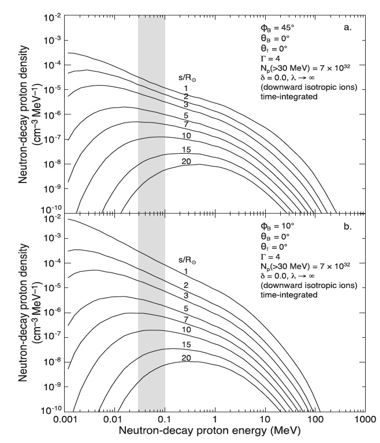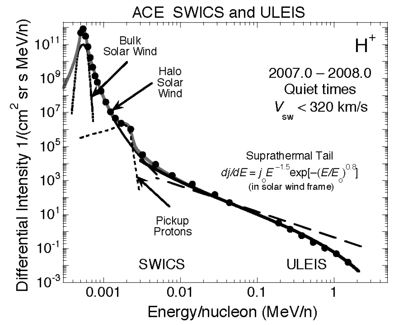Can Solar Flare Neutron-Decay Protons
Provide a Seed Population for CME Shock Acceleration?
PDF version

|

|
| Figure 1: Neutron-decay proton densities for the indicated conditions and for 10° (a) and 45° (b) magnetic connections (Murphy & Ko, 2017). The grey band marks the energy band considered most effective for injection into the acceleration process. | Figure 2: Differential intensity spectra of protons extending from solar wind out to 1 MeV as measured ACE/SWICS and ACE/ULEIS during solar quiet times with solar wind speeds of <320 km/s (from Gloeckler et al. in AIP Volume 1039, 2008). Murphy & Ko extrapolated these spectra to estimate quiet-time intensities in the low corona. |
Neutrons are among the reaction products produced in large solar flares when accelerated ions encounter the solar atmosphere. In a 2010 paper (JGR 115, A01102, 2010) Feldman et al. suggested that solar-flare neutrons that decay to protons in the low corona could provide a seed-population for CME-driven shock acceleration. Murphy and Ko (ApJ 846:53, 2017) recently tested this idea by modeling the production of 1 keV to 100 MeV protons in the low corona by the decay of neutrons produced in a large solar flare. Free neutrons undergo decay (n→p + e- + νe) with a mean-life of ~882 seconds. This process produces protons with slightly less kinetic energy than the escaping neutrons. The protons and electrons spiral around the local interplanetary magnetic field and are convected out by the solar wind.
To model neutron production they assumed 7 x 1032 accelerated protons >30 MeV, a value characteristic of the large June 4, 1991 X12 flare (Murphy et al. ApJ 490:883, 1997). To optimize the neutron yield they assumed a composition enriched in He (α/p=0.1) and heavier ions. They also chose angular distributions of interacting protons to optimize the yield of escaping neutrons. Figure 1 shows the time-integrated neutron-decay proton density spectra for two foot-point longitudes (10° and 45°) as a function of distance from the Sun in solar radii [1AU = 213 solar radii (RS)].
In order to compare the modeled neutron-decay proton spectra to an estimated quiet-time ambient density they used quiet-time energy spectra measured in 2007 by the SWICS and ULEIS instruments on ACE (see Figure 2). Assuming the intensity scales as 1/r2 with radial distance they derived a "quiet-time" 100 keV proton density at 1 RS of 3.3 x 10-3/(cm3MeV), which is ~30 times larger than the modeled neutron-decay proton density in Figure 1b. This suggests that neutron-decay protons make a negligible contribution to quiet-time seed-particle densities near the Sun.
This item was contributed by R.A. Mewaldt of Caltech. Address questions and comments to
ACE News Archives
Subscribe to ACE News
ACE Homepage
Last modified 19 Mar 2018.